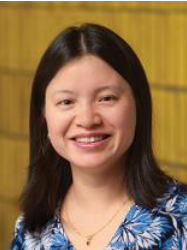Programmable shape-shifting materials can take different physical forms to achieve multifunctionality in a dynamic and controllable manner. We take geometry from nano- to macroscales by (re)programming anisotropy in liquid crystal elastomers (LCEs) and their nanocomposites in the forms of films, fibers, and droplets. Through inverse engineering, that is pre-programming inhomogeneous local deformations in LCEs, we show shape morphing into arbitrary 3D shapes. By incorporating 1D and 2D nanomaterials (e.g. cellulose nanocrystals, carbon nanotubes, graphene and gold nanorods) in LCEs, we demonstrate tendon-like actuators and reprogrammable shape transformation in response to heat, light, magnetic field, electric field and pneumatic actuations. In my talk, I will show several potential applications, including soft robotics and 3D displays.

Dr. Shu Yang is a Joseph Bordogna Professor of Engineering and Applied Science, Chair of the Department of Materials Science & Engineering, and Professor of Chemical & Biomolecular Engineering at University of Pennsylvania. Her group is interested in synthesis, fabrication, and assembly of soft matter; dynamic tuning of their sizes, shapes and assembled structures, and use geometry to create highly flexible, super-conformable, and shape changing materials for potential applications, including self-cleaning coatings, structural colors, adhesives, smart windows, sensors, actuators for robotics and biomedical devices. Yang received her B.S. degree from Fudan University, and Ph. D. degree from Cornell University. She worked at Bell Laboratories, Lucent Technologies as a Member of Technical Staff before joining Penn. She received George H. Heilmeier Faculty Award for Excellence in Research from Penn Engineering and was selected as one of the world’s top 100 young innovators under age of 35 by MIT's Technology Review. She is a Fellow of Materials Research Society (MRS), Division of Soft Matter (DSOFT) from American Physical Society (APS), Division of Polymeric Materials: Science and Engineering from American Chemical Society (ACS), Royal Chemical Society, and National Academy of Inventors.
